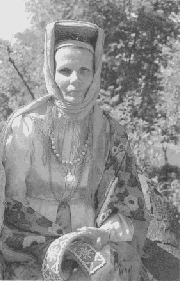 They call themselves saam´ or saam´lja (on the Kola Peninsula), sabme, sabmelas^ (pl. sabmela at). Other nations have called them Fenn (Finn) and since the 12th century, Lapp (e.g. the form Lop' appears in Old Russian Chronicles at about 1000 AD). The use of the name Saam has been propagated in Russia since the 1920s and in Scandinavia within the last decades. The Sámis themselves consider the name Lapp pejorative. Sámis have six literary languages: Southern Sámi (Norway), Lule Sámi (Sweden), Northern Sámi (Sweden, Finland and Norway), Inari and Skolt Sámi (Finland), Kildin Sámi (Russia). They call themselves saam´ or saam´lja (on the Kola Peninsula), sabme, sabmelas^ (pl. sabmela at). Other nations have called them Fenn (Finn) and since the 12th century, Lapp (e.g. the form Lop' appears in Old Russian Chronicles at about 1000 AD). The use of the name Saam has been propagated in Russia since the 1920s and in Scandinavia within the last decades. The Sámis themselves consider the name Lapp pejorative. Sámis have six literary languages: Southern Sámi (Norway), Lule Sámi (Sweden), Northern Sámi (Sweden, Finland and Norway), Inari and Skolt Sámi (Finland), Kildin Sámi (Russia).
There are different data about the Sámi population, depending on the criteria of determining one's ethnicity. For example, ever since 1962 the basic criterion in Finland has been language. There those are considered Sámis whose grandparent(s) (at least one of them) acquired Sámi as the primary language, or who speak Sámi as their primary language. In Norway and Sweden the basic criterion is the relation to reindeer-herding. In these countries citizenship is not separated from nationality, and therefore the number of Sámis cannot be determined unambiguously. According to the Sami Council there are 30,000-70,000 Sámis in Scandinavia.
Of the Sámis living in Finland and Russia there are more exact data. In 1984 there were 11,475 inhabitants in the Sámi region of Finland (Lapin lääni), 3,892 of them were Sámis, which makes 32.9% of the total population. In the Sámi region of Russia (Murmansk Province) there were 1,115,000 inhabitants in 1989, the 1,890 Sámis constituting 0.15% of them. Within 63 years the Kola Sámis' command of their mother tongue has decreased drastically (55.8%).
In the whole, the history of the Sámis is the history of their centuries-long withdrawal from other peoples towards the Arctic Ocean.
9th c - a massive northward migration of the Sámis begins, as the Vikings occupy the area around Lake Ladoga. In Norway and Sweden the taxing and trading rights on the territory of the Sámis are granted to the lords; the inhabitants of Häme and Karelia also practise taxation by robbery;
13th c - the Kola Peninsula comes under the Russian influence;
16th c - the Sámis of Kola are baptised into Russian Orthodoxy;
17th c - Lutheran mission reaches the Western Sámis;
1673 - King Karl XI of Sweden begins to consciously direct Swedish and Finnish colonists to the Sámi areas; Sámis become a minority in their native territory;
1868 - beginning of the colonisation of the Kola Peninsula with resident settlers, mostly Russians. The promotion of resident Russian life-style has Russified entire Sámi villages by the turn of the century;
1930s - formation of collective farms, severe measures of conversion of the nomadic Sámis to resident settlers, expropriation of large tracts of land for industrial and military use, stopping of all educational activities and abolition of the literary language in 1937, destruction of all Sámi printed texts;
ca. 1940-60 - the policy of 'transforming' Sámis into Norwegians, Swedes, Finns; in boarding schools Sámi children are alienated from their people and mother tongue
|













 State
State  Nations of Russia
Nations of Russia